Books by Muhammad Waziri
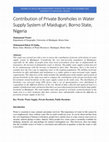
This study was carried out with a view to assess the contribution of private of boreholes in wate... more This study was carried out with a view to assess the contribution of private of boreholes in water supply system in Maiduguri. Considering the very fast-growing population of Maiduguri, especially by the influx of people from most local government areas due to displacement by insurgency, the increase in demand for water is obvious. The public water supply system may not be in commensurate with the increase in demand in short time. Therefore, there is the need to examine how the City cope in supplying water to the teaming population. The drilling of private boreholes by able individuals and institutions is a viable option to meet personal water supply requirements. The objectives of the study includes the identification of the number and location of private boreholes in the study area and to compare the contribution of the private boreholes and Government owned boreholes in the water supply system in the study area. The distribution of boreholes was surveyed using GPS device and a set of questionnaires were distributed to respondents in the different districts of the city. Result of data collected and analyzed lead to a number of deductions and conclusions that there are more functional private boreholes than public boreholes in Maiduguri. The total number and wide spread of privately owned boreholes in the study area is a clear testimony that their existence have substantially reduced the difficulty in provision of water supply in the City.
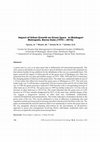
Journal of Environmental Technology, 2020
A green area in a city is an open space that is deliberately left untouched permanently. The tree... more A green area in a city is an open space that is deliberately left untouched permanently. The trees, grasses and shrubs in a green area have special attributes associated with a planned city that nurture healthy living condition for the inhabitants of the city on a sustainable basis. The paper assessed the impact of urban growth on the green areas of Maiduguri city. Data was generated from the city plan and satellite images of 1975, 1986, 1999 and 2015 to determine the changing pattern of land use in the green areas. The study was conducted within an area of a 10 km radius that effectively housed the green areas of Maiduguri in 1975. The total area under study was 31,428 hectares comprising 3245 ha of green areas and 28,183 of other land use. In 1986 the green areas have reduced to 1889 hectares with a corresponding increase in other land use to 29,539 ha. The green area in 1999 has further reduced to 1114 ha with an increase of other land uses to 30,314 ha. The result indicated that the green area of 3,245 hectares in 1975 has virtually disappeared by 2015. At the same time, satellite images of the city suggest a progressive increase in other land uses (residential, institutional, commercial/industrial and transportation). The results indicated a tremendous decline in the green areas of the city. This can be attributed to a lack of adherence to planning rules and regulation and the growing need for housing and other infrastructural facilities in the city. The paper recommends the need for land-use land cover monitoring to restore the green areas in the city, pragmatic physical planning intervention by the government, an all-inclusive approach to green area management involving NGOs, individuals, traditional rulers and advocacy to regain the cities green areas among others.
Explains the meanings of personal name the Kanuri people of NE Nigeria bear. The category of name... more Explains the meanings of personal name the Kanuri people of NE Nigeria bear. The category of names identified include Real name, To-names, Titular names, Cover names and Nick names.
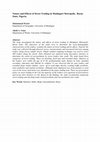
Journal of Social and Management Sciences, 2016
The study investigated the nature and effects of street trading in Maiduguri Metropolis, Borno St... more The study investigated the nature and effects of street trading in Maiduguri Metropolis, Borno State. The objectives of the study were to determine the socio-demographic characteristics of the traders, examine the nature of street trading and its effects. Data for the study was collected through physical survey, measurements and structured interview among traders along eleven sample streets. Simple random sampling technique was used to select 400 traders along the streets. Data obtained was analyzed using descriptive statistics to determine the extent of encroachment by street traders into roads. The study found three categories of street trading. These are hawking, fixed spot and extended shops. Majority of the traders were within the age of 21-30, predominantly male, Kanuri by tribe, attended secondary education and Muslim by religion. It was observed that fix spot traders and extended shops traders display wares up to road edges thereby creating traffic problems, noise pollution and sanitary problems. Although items displayed vary from peanuts to used cars on the street, food items were identified as the major trading item. There are government policy on street trading in the City but majority of the traders were ignorant of such policies and locate their business at will. Based on the findings, the study recommends organizing street trading and checking trade-related problems and encroachments into roads.
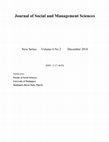
Journal of Social and Management Sciences, 2018
Abstract
Residential segregation is the concentration of people of similar identity, ethnicity or... more Abstract
Residential segregation is the concentration of people of similar identity, ethnicity or nationality in a specific location in a city. It is the tendency for persons of similar origin to form residential cluster in a location in an urban area. Residential segregation is a social issue occurring in both developed and developing countries around the globe stratifying people along ethnic, social class or religion in cities. However, its origin and extent varies from one nation to the other and even in one country from one city to the other. Maiduguri is a cosmopolitan city where almost all Nigerian ethnic groups and those from neighbouring countries are found. The objectives of the study are to determine the origin, nature, trend and extent of residential segregation in Maiduguri. The method used were field survey and a cross sectional survey of four hundred respondents drawn from thirteen randomly selected wards out of the twenty-one political wards in the study area. The study found out that, the origin of residential segregation in Maiduguri was dated back to its founding in 1907 when Kanuri from Kukawa and Dikwa migrated to Maiduguri. Kanuri with a long history of administration in Kanemi Bornu Empire were given special treatment by the colonial masters and were settled in Shehuri Ward at the request of the Shehu. This act then succeeded in stratifying urban Maiduguri into socio-cultural, ethnic and religious groupings. However, with the unfolding of urbanism process in Yerwa, the intensity and trend of segregation has been changing as more and more people are coming into the new city. This also leads to the sprawling of new settlements and other social factors that create room for the emergence of residential segregation in the area.At the moment heterogeneous settlement pattern exist, especially in the sprawling wards such as Mairi, Bulumkutu ,Bolori and Gwange.
Key Word: Residential Segregation
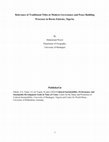
Ododo, S E, Tijani, A I, & Vogels, R (eds) (2020) Cultural Sustainability, Performance and Sustainable Development Goals in Time of Crisis, Centre for the Study and Promotion of Cultural Sustainability, University of Maiduguri, Nigeria and Centre for World Music, University of Hildesheim, Germany, 2020
Abstract
Borno Emirate has been existing as an organized political entity for over a millennium. ... more Abstract
Borno Emirate has been existing as an organized political entity for over a millennium. It has a traditional administrative set up with hierarchy of titles and powers that governed the polity of the ancient State for very long time. The Mai, in early history and later the Shehu were the paramount rulers who governed the territories and vassals through titled appointees and representatives of different grades down the hierarchy. Islam being the state religion, courts were established to adjudicate civil and criminal matters according to the Sharia with the Shehu’s court as the supreme. However with the coming of European colonialism to Borno, the powers of the traditional system was absorbed by the colonialists which reduced the traditional system to puppet to the colonialist whims and caprices. After being amalgamated into the Nigerian Federation, the powers of the traditional system continued to be subjugated to the government of the federation even after independence. Nevertheless the traditional structure of governance continue to exist though without constitutional recognition. They function merely as a symbol of culture and tradition under the control of government and often used as a catalyst for mobilization for support of government policies and programs. The traditional administration is given the privilege to maintain influence over their traditional territories by appointing traditional administrators, deputies and heads of different categories and for different units. Appointees are conferred with titles some of which are functional in assisting modern governance. This paper identifies the titles and discusses the process of appointments, conferment, functions and their relevance in the modern Nigerian State especially in ensuring good governance and peace building processes between and among adherents of the system.
It explains the culture of horse keeping among the Kanuri people especially in Borno in Nigeria.
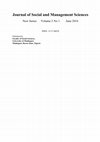
Abstract
This study investigated the nature and effects of street trading in Maiduguri Metropolis... more Abstract
This study investigated the nature and effects of street trading in Maiduguri Metropolis, Borno State. The objectives of the study were to determine the socio-demographic characteristics of the traders and examine the nature of street trading and its effects. Data for the study was collected through physical survey, measurements and structured interview among traders along eleven sample streets. Simple random sampling technique was used to select 220 traders along the streets. Data obtained was analyzed using descriptive statistics to determine the characteristics of the traders and the extent of encroachment by street traders into roads. The study observed that majority of the traders were within the age of 21-30, predominantly male, most of whom are Kanuri by tribe, and Muslims by religion and majority have not gone beyond secondary education. The study found three categories of street trading. These were hawking, fixed spot trading and extended shops. It was observed that fix spot traders and extended shops traders displayed wares up to road edges thereby creating traffic problems, noise pollution and sanitary problems. Items offered in street trading vary from peanuts to used cars, however food items were identified as the major trading item. There are governments policies on street trading in the City but majority of the traders were ignorant of such policies and locate their business at will. Based on the findings, the study recommends organizing street trading and checking trade-related problems and encroachments into roads.
Key Words: Hawkers, Stalls, Shops, Encroachment, Street
Papers by Muhammad Waziri
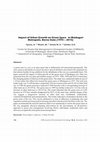
A green area in a city is an open space that is deliberately left untouched permanently. The tree... more A green area in a city is an open space that is deliberately left untouched permanently. The trees, grasses and shrubs in a green area have special attributes associated with a planned city that nurture healthy living condition for the inhabitants of the city on a sustainable basis. The paper assessed the impact of urban growth on the green areas of Maiduguri city. Data was generated from the city plan and satellite images of 1975, 1986, 1999 and 2015 to determine the changing pattern of land use in the green areas. The study was conducted within an area of a 10 km radius that effectively housed the green areas of Maiduguri in 1975. The total area under study was 31,428 hectares comprising 3245 ha of green areas and 28,183 of other land use. In 1986 the green areas have reduced to 1889 hectares with a corresponding increase in other land use to 29,539 ha. The green area in 1999 has further reduced to 1114 ha with an increase of other land uses to 30,314 ha. The result indicated that...
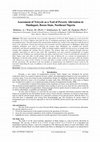
This paper assessed the socioeconomic importance of Tricycle (Keke Napep) as a tool of poverty al... more This paper assessed the socioeconomic importance of Tricycle (Keke Napep) as a tool of poverty alleviation. It is service industry task with the role of commuting passengers and their light freight across a geographical space. The full weight of the transportation medium was exerted on the study area with the ban of motor cycle operations. It forms part of many socioeconomic activities taking place in Maiduguri. Multi stage sampling techniques were used in collecting the primary data. Maiduguri was stratified into densely, moderately and sparsely populated areas. Table of random numbers guided selection process of sample from stratum after mapping the existing Tricycle stations. The primary data were obtained through interview schedule, observation as well as trip count. The respondents were also selected systematically at regular defined interval. Findings were analysed using descriptive statistical tools. It was revealed that the operation of Keke Napep come into effect in full pledge with the ban of Motorcycle as a means of transportation in Maiduguri. It absorbs large number of productive male gender into the trade as operators while the females only surfaced as owners of the vehicles. It is par with other economic activities in terms of employment and income generation. The operation of the new medium of transportation was hindered to larger extent by the insecurity bedevilling the state. In addition to the security threat, double and over taxation were also forces of retardation.

Background: The border between Nigeria and Cameroun stretches for hundreds of kilometers. The mov... more Background: The border between Nigeria and Cameroun stretches for hundreds of kilometers. The movement of patients from Maiduguri, NE Nigeria int o Cameroun’s border hospitals is becoming very popular. This study investigated the categories of people involved in such movement, their healthcare needs in Cameroun and the motivation behind the mov e ent. Methods: In-depth interviews with fifteen participa nts (patients) who received treatment in Cameroun’s border hospitals and two health workers (doctors) w ere conducted. The patients were recruited through a snowball sampling technique. Analysis was done th rough a manual coding of the main themes of the interview which were collated and interpreted. Results: Respondents were predominantly male and ag e but cutting across wide socio-economic stratum. Ophthalmic care was the predominant care s ought by patients. Perceived higher quality of care in Cameroun which embodies expertise, shorter durat ion of treatment, quality of drugs, and ...
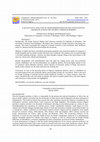
Background: The border between Nigeria and Cameroun stretches for hundreds of kilometers. The
mov... more Background: The border between Nigeria and Cameroun stretches for hundreds of kilometers. The
movement of patients from Maiduguri, NE Nigeria into Cameroun’s border hospitals is becoming very
popular. This study investigated the categories of people involved in such movement, their healthcare
needs in Cameroun and the motivation behind the movement.
Methods: In-depth interviews with fifteen participants (patients) who received treatment in Cameroun’s
border hospitals and two health workers (doctors) were conducted. The patients were recruited through
a snowball sampling technique. Analysis was done through a manual coding of the main themes of the
interview which were collated and interpreted.
Results: Respondents were predominantly male and aged but cutting across wide socio-economic
stratum. Ophthalmic care was the predominant care sought by patients. Perceived higher quality of care
in Cameroun which embodies expertise, shorter duration of treatment, quality of drugs, and positive
health worker attitude was the main motivation for seeking care.
Conclusion: In view of the decaying nature of Nigeria’s healthcare delivery, there is a likelihood of
increased patient flows into Cameroun unless current health reforms are concretized. There is the need
for formal exchange of patients between border healthcare facilities as a policy measure. Since this
study considered only-way movement of patients, the need to examine patient flows into both Nigeria
and Cameroun in future studies was highlighted.
KEYWORDS: cross-border, healthcare, eye-care, Kolofata
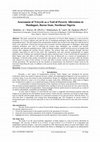
This paper assessed the socioeconomic importance of Tricycle (Keke Napep) as a tool of poverty al... more This paper assessed the socioeconomic importance of Tricycle (Keke Napep) as a tool of poverty alleviation. It is service industry task with the role of commuting passengers and their light freight across a geographical space. The full weight of the transportation medium was exerted on the study area with the ban of motor cycle operations. It forms part of many socioeconomic activities taking place in Maiduguri. Multi stage sampling techniques were used in collecting the primary data. Maiduguri was stratified into densely, moderately and sparsely populated areas. Table of random numbers guided selection process of sample from stratum after mapping the existing Tricycle stations. The primary data were obtained through interview schedule, observation as well as trip count. The respondents were also selected systematically at regular defined interval. Findings were analysed using descriptive statistical tools. It was revealed that the operation of Keke Napep come into effect in full pledge with the ban of Motorcycle as a means of transportation in Maiduguri. It absorbs large number of productive male gender into the trade as operators while the females only surfaced as owners of the vehicles. It is par with other economic activities in terms of employment and income generation. The operation of the new medium of transportation was hindered to larger extent by the insecurity bedevilling the state. In addition to the security threat, double and over taxation were also forces of retardation.
The book is an exposition of certain issues observed in various disciplines that are unique to th... more The book is an exposition of certain issues observed in various disciplines that are unique to the geographical set up of Borno State as a region. Systematic studies of some physical and human issues are made to give insight to the nature of such issues in Borno as a region. The book is divided into five sections which includes an introductory section that outlines the geographical characteristics and historical evolution of the region; a section each on physiographic and economic issues in the region as well as sections on human health and water resource management respectively


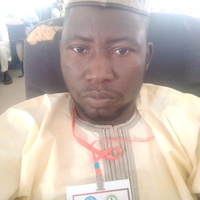

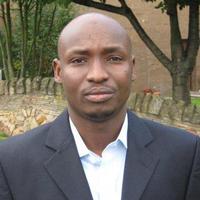






Uploads
Books by Muhammad Waziri
Residential segregation is the concentration of people of similar identity, ethnicity or nationality in a specific location in a city. It is the tendency for persons of similar origin to form residential cluster in a location in an urban area. Residential segregation is a social issue occurring in both developed and developing countries around the globe stratifying people along ethnic, social class or religion in cities. However, its origin and extent varies from one nation to the other and even in one country from one city to the other. Maiduguri is a cosmopolitan city where almost all Nigerian ethnic groups and those from neighbouring countries are found. The objectives of the study are to determine the origin, nature, trend and extent of residential segregation in Maiduguri. The method used were field survey and a cross sectional survey of four hundred respondents drawn from thirteen randomly selected wards out of the twenty-one political wards in the study area. The study found out that, the origin of residential segregation in Maiduguri was dated back to its founding in 1907 when Kanuri from Kukawa and Dikwa migrated to Maiduguri. Kanuri with a long history of administration in Kanemi Bornu Empire were given special treatment by the colonial masters and were settled in Shehuri Ward at the request of the Shehu. This act then succeeded in stratifying urban Maiduguri into socio-cultural, ethnic and religious groupings. However, with the unfolding of urbanism process in Yerwa, the intensity and trend of segregation has been changing as more and more people are coming into the new city. This also leads to the sprawling of new settlements and other social factors that create room for the emergence of residential segregation in the area.At the moment heterogeneous settlement pattern exist, especially in the sprawling wards such as Mairi, Bulumkutu ,Bolori and Gwange.
Key Word: Residential Segregation
Borno Emirate has been existing as an organized political entity for over a millennium. It has a traditional administrative set up with hierarchy of titles and powers that governed the polity of the ancient State for very long time. The Mai, in early history and later the Shehu were the paramount rulers who governed the territories and vassals through titled appointees and representatives of different grades down the hierarchy. Islam being the state religion, courts were established to adjudicate civil and criminal matters according to the Sharia with the Shehu’s court as the supreme. However with the coming of European colonialism to Borno, the powers of the traditional system was absorbed by the colonialists which reduced the traditional system to puppet to the colonialist whims and caprices. After being amalgamated into the Nigerian Federation, the powers of the traditional system continued to be subjugated to the government of the federation even after independence. Nevertheless the traditional structure of governance continue to exist though without constitutional recognition. They function merely as a symbol of culture and tradition under the control of government and often used as a catalyst for mobilization for support of government policies and programs. The traditional administration is given the privilege to maintain influence over their traditional territories by appointing traditional administrators, deputies and heads of different categories and for different units. Appointees are conferred with titles some of which are functional in assisting modern governance. This paper identifies the titles and discusses the process of appointments, conferment, functions and their relevance in the modern Nigerian State especially in ensuring good governance and peace building processes between and among adherents of the system.
This study investigated the nature and effects of street trading in Maiduguri Metropolis, Borno State. The objectives of the study were to determine the socio-demographic characteristics of the traders and examine the nature of street trading and its effects. Data for the study was collected through physical survey, measurements and structured interview among traders along eleven sample streets. Simple random sampling technique was used to select 220 traders along the streets. Data obtained was analyzed using descriptive statistics to determine the characteristics of the traders and the extent of encroachment by street traders into roads. The study observed that majority of the traders were within the age of 21-30, predominantly male, most of whom are Kanuri by tribe, and Muslims by religion and majority have not gone beyond secondary education. The study found three categories of street trading. These were hawking, fixed spot trading and extended shops. It was observed that fix spot traders and extended shops traders displayed wares up to road edges thereby creating traffic problems, noise pollution and sanitary problems. Items offered in street trading vary from peanuts to used cars, however food items were identified as the major trading item. There are governments policies on street trading in the City but majority of the traders were ignorant of such policies and locate their business at will. Based on the findings, the study recommends organizing street trading and checking trade-related problems and encroachments into roads.
Key Words: Hawkers, Stalls, Shops, Encroachment, Street
Papers by Muhammad Waziri
movement of patients from Maiduguri, NE Nigeria into Cameroun’s border hospitals is becoming very
popular. This study investigated the categories of people involved in such movement, their healthcare
needs in Cameroun and the motivation behind the movement.
Methods: In-depth interviews with fifteen participants (patients) who received treatment in Cameroun’s
border hospitals and two health workers (doctors) were conducted. The patients were recruited through
a snowball sampling technique. Analysis was done through a manual coding of the main themes of the
interview which were collated and interpreted.
Results: Respondents were predominantly male and aged but cutting across wide socio-economic
stratum. Ophthalmic care was the predominant care sought by patients. Perceived higher quality of care
in Cameroun which embodies expertise, shorter duration of treatment, quality of drugs, and positive
health worker attitude was the main motivation for seeking care.
Conclusion: In view of the decaying nature of Nigeria’s healthcare delivery, there is a likelihood of
increased patient flows into Cameroun unless current health reforms are concretized. There is the need
for formal exchange of patients between border healthcare facilities as a policy measure. Since this
study considered only-way movement of patients, the need to examine patient flows into both Nigeria
and Cameroun in future studies was highlighted.
KEYWORDS: cross-border, healthcare, eye-care, Kolofata
Residential segregation is the concentration of people of similar identity, ethnicity or nationality in a specific location in a city. It is the tendency for persons of similar origin to form residential cluster in a location in an urban area. Residential segregation is a social issue occurring in both developed and developing countries around the globe stratifying people along ethnic, social class or religion in cities. However, its origin and extent varies from one nation to the other and even in one country from one city to the other. Maiduguri is a cosmopolitan city where almost all Nigerian ethnic groups and those from neighbouring countries are found. The objectives of the study are to determine the origin, nature, trend and extent of residential segregation in Maiduguri. The method used were field survey and a cross sectional survey of four hundred respondents drawn from thirteen randomly selected wards out of the twenty-one political wards in the study area. The study found out that, the origin of residential segregation in Maiduguri was dated back to its founding in 1907 when Kanuri from Kukawa and Dikwa migrated to Maiduguri. Kanuri with a long history of administration in Kanemi Bornu Empire were given special treatment by the colonial masters and were settled in Shehuri Ward at the request of the Shehu. This act then succeeded in stratifying urban Maiduguri into socio-cultural, ethnic and religious groupings. However, with the unfolding of urbanism process in Yerwa, the intensity and trend of segregation has been changing as more and more people are coming into the new city. This also leads to the sprawling of new settlements and other social factors that create room for the emergence of residential segregation in the area.At the moment heterogeneous settlement pattern exist, especially in the sprawling wards such as Mairi, Bulumkutu ,Bolori and Gwange.
Key Word: Residential Segregation
Borno Emirate has been existing as an organized political entity for over a millennium. It has a traditional administrative set up with hierarchy of titles and powers that governed the polity of the ancient State for very long time. The Mai, in early history and later the Shehu were the paramount rulers who governed the territories and vassals through titled appointees and representatives of different grades down the hierarchy. Islam being the state religion, courts were established to adjudicate civil and criminal matters according to the Sharia with the Shehu’s court as the supreme. However with the coming of European colonialism to Borno, the powers of the traditional system was absorbed by the colonialists which reduced the traditional system to puppet to the colonialist whims and caprices. After being amalgamated into the Nigerian Federation, the powers of the traditional system continued to be subjugated to the government of the federation even after independence. Nevertheless the traditional structure of governance continue to exist though without constitutional recognition. They function merely as a symbol of culture and tradition under the control of government and often used as a catalyst for mobilization for support of government policies and programs. The traditional administration is given the privilege to maintain influence over their traditional territories by appointing traditional administrators, deputies and heads of different categories and for different units. Appointees are conferred with titles some of which are functional in assisting modern governance. This paper identifies the titles and discusses the process of appointments, conferment, functions and their relevance in the modern Nigerian State especially in ensuring good governance and peace building processes between and among adherents of the system.
This study investigated the nature and effects of street trading in Maiduguri Metropolis, Borno State. The objectives of the study were to determine the socio-demographic characteristics of the traders and examine the nature of street trading and its effects. Data for the study was collected through physical survey, measurements and structured interview among traders along eleven sample streets. Simple random sampling technique was used to select 220 traders along the streets. Data obtained was analyzed using descriptive statistics to determine the characteristics of the traders and the extent of encroachment by street traders into roads. The study observed that majority of the traders were within the age of 21-30, predominantly male, most of whom are Kanuri by tribe, and Muslims by religion and majority have not gone beyond secondary education. The study found three categories of street trading. These were hawking, fixed spot trading and extended shops. It was observed that fix spot traders and extended shops traders displayed wares up to road edges thereby creating traffic problems, noise pollution and sanitary problems. Items offered in street trading vary from peanuts to used cars, however food items were identified as the major trading item. There are governments policies on street trading in the City but majority of the traders were ignorant of such policies and locate their business at will. Based on the findings, the study recommends organizing street trading and checking trade-related problems and encroachments into roads.
Key Words: Hawkers, Stalls, Shops, Encroachment, Street
movement of patients from Maiduguri, NE Nigeria into Cameroun’s border hospitals is becoming very
popular. This study investigated the categories of people involved in such movement, their healthcare
needs in Cameroun and the motivation behind the movement.
Methods: In-depth interviews with fifteen participants (patients) who received treatment in Cameroun’s
border hospitals and two health workers (doctors) were conducted. The patients were recruited through
a snowball sampling technique. Analysis was done through a manual coding of the main themes of the
interview which were collated and interpreted.
Results: Respondents were predominantly male and aged but cutting across wide socio-economic
stratum. Ophthalmic care was the predominant care sought by patients. Perceived higher quality of care
in Cameroun which embodies expertise, shorter duration of treatment, quality of drugs, and positive
health worker attitude was the main motivation for seeking care.
Conclusion: In view of the decaying nature of Nigeria’s healthcare delivery, there is a likelihood of
increased patient flows into Cameroun unless current health reforms are concretized. There is the need
for formal exchange of patients between border healthcare facilities as a policy measure. Since this
study considered only-way movement of patients, the need to examine patient flows into both Nigeria
and Cameroun in future studies was highlighted.
KEYWORDS: cross-border, healthcare, eye-care, Kolofata